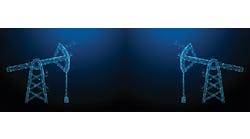One of the most important tasks of digitalized data analytics is enabling users to not just optimize present operations, but project and enable future performance, too.
"Data analytics have been around forever because manufacturers need to turn raw data into actionable information. That requires collecting your data, framing it in context, then using that information to prescribe and proactively address issues," says Sam Russem, smart manufacturing director at Grantek, a CSIA-certified system integrator and business and manufacturing consultant with 17 offices worldwide. "It used to be good enough to assess past performance, but now we’re being challenged to look to the future and be more predictive and proactive.
"Where we used to do advanced process control (APC) and simulations, we're now using more big data and machine learning (ML) methods to drive larger insights. However, despite these opportunities, there are still many manufacturers with no predictive capabilities, and no links between their PLC functions and manufacturing execution systems (MES) to provide the contextual information they need. This is a good indication they can do more with analytics and should experiment with it, even if they're just getting information from a historian. We usually ask them to give us a list of 10 problems they're experiencing and the equipment involved, so they can begin to experiment and develop return on investment (ROI) scenarios."
Russem reports data analytics can start with a good historian that collects information on temperatures, run rates or other parameters, and then adds them to a software-based model that puts the data in context, which is needed to show scalability and ROI for a project. These tools include OSIsoft's PI Asset Framework, Rockwell Automation's FactoryTalk, and Inductive Automation's Ignition HMI/SCADA software. These and other packages can support analytics projects by organizing data according to the ISA 95 equipment hierarchy and other standard models for efficient and effective analysis. He adds that modeling data is usually a prerequisite for using open technologies such as an MES, as well as beginning a digital transformation journey, but it's also essential to have input from operators and other end users.
"Analytics and smart manufacturing stakeholders must be able to talk about their processes, how production is organized, how equipment is connected, and actually agree with those assessments across departments," adds Russem. "Data models don’t always add value on their own, so their success depends on performing these next steps. This is why our group has been working with more MES applications this year, and setting up models and data structures that can enable overall equipment effectiveness (OEE) rollouts. Likewise, any pilot project can begin with figuring out what data is needed, which points the way to what needs to be on a report or dashboard."
Of course, for data to be analyzed, the sensors, I/O and PLCs generating it must be connected to a network, usually Ethernet, which means connections may need to be established for many older devices, or they may need to be replaced. "There are still many boxes and software taking data from older systems, but you can't drop a cable or fiber line to every production device, so it's better to use data communication standards like OPC UA or MQTT," says Russem. "It’s not uncommon to have new analytics projects that don't involve any hardware deployed onsite. Instead, we start with the data we're collecting in historians and data servers today, and see where it can take us and provide value. What's really cool now is ML algorithms and predictive analytics are beginning to go to the cloud, where they can use more computing power at a lower price. This makes it even more important to have cybersecurity in place, so data can move securely in and out of its process and facility."
Russem adds it also helps to have a single source for all the data in a process or plant, such as its onsite MES. Even if there isn't an MES onsite, there may be other ways to get the data and context that's needed. "Most factories already have production, quality and inventory management functions in place, but they're being carried out by various systems or people. These include scheduling and OEE for production and traceability for inventory," he says. "It's a sad joke that the most popular MES displays are Microsoft Excel spreadsheets, and communicating data to and from enterprise resource planning (ERP) programs are manual operations. A modern, software MES connects directly to an ERP system and help to automate these production, quality, inventory and maintenance functions."
Russem cautions that data analytics projects can also false start if they misinterpret their ROI. For example, if advanced analytics software costs $50,000, but the ROI for evaluating drive and motor performance and improving maintenance is only $30,000, then the project isn't cost effective. However, if analytics can monitor a batch and help make sure it doesn't drift out of spec, then it can likely generate worthwhile savings. "Data analytics can also monitor cleaning parameters and deliver feedback to save time in clean in place (CIP) operations, or use the amps being drawn by the motor on a mixer to infer dough consistency, instead of relying on the usual timer," adds Russem. "So, even though we can do data analytics from the edge to the cloud, what's still most important is finding and matching the right tool for each application, instead of making users adapt to the tool."






